Abstract
Wind turbines are one of the leading renewable sources of electricity. They are located in areas where the energy potential of the wind is high and more or less permanent. Their efficient operation depends on certain technical characteristics of the entire wind system (wind turbines, generator, automation system, regulation, and control). This paper analyses experimental data from wind turbines, WT, in the Dobrogea area: wind speed, v, velocity, n, and power, PEG, at the electric generator, EG. These are used to identify the local maxima of wind turbine power at different wind speeds. Based on this, a mathematical model for wind turbines and the power losses caused by inefficient control are determined. The mathematical model is used to visualize the maximum energy zones. At the end of this study, an algorithm is given that allows for the visualization of the optimal energy zone. The algorithm resulting from the analyzed case studies can be implemented by the control system in order to maximize the produced electricity with any variation in wind speed.
1. Introduction
1.1. Background Information
Wind forecasting techniques are used for the integration of wind turbines into the electricity market and their dispatch. In this way, it is possible to forecast the amount of energy produced, taking into account the dynamics of the electricity market, which are determined by the demand for electricity [1,2], and synchronized with the power curve of the installed wind turbines, which predicts the output as a function of the wind speed [3]. In order to know the wind speed variation curves, it is necessary to make recordings over sufficiently long periods using anemometric towers. In many cases, these data are used in mathematical models to determine monthly wind speed maxima [4]. All these measurements can be used for the individual design of wind turbines, as well as for their selection from a standardized range [5].
Certain methods and control algorithms are chosen depending on the type of turbine and the mode of operation [6,7,8,9]. Adaptive [10] or dynamic control can be used for partial load and rated load operation. This allows for the wind turbine to be controlled even during rapid discharges, when the transient rotor speed tends to increase beyond the limits [11,12,13]. To ensure the more flexible operation of wind farms and turbines, a power monitoring architecture has been proposed through an individual interface with each turbine. The proposed monitoring architecture does not require multiple pieces of information about the turbine dynamics [14]. If a power oscillation damping controller is used, it will affect the wind turbine system to a similar or lesser extent than the wind speed variations [15]. In the case of wind turbines equipped with double-fed induction generators (DFIG), it has been proposed to use a different algorithm to determine the maximum power point using the electrical power values delivered at the output. Based on these values, the wind speed and turbine shaft speed are estimated, allowing for continuous control of the maximum power point operation without the need for a wind speed or turbine shaft speed sensor [16]. There are situations where the simulated peak power point values are higher than those obtained during operation. This can be caused by additional friction that can occur in the cooling system [17].
The value of the optimum mechanical angular velocity, ωOPTIM, and the power at the electrical generator, PEG, depend on the value of the wind speed, v, which are generally [18,19,20,21,22] not well known. The maximum capture of wind energy can only be achieved with the correct mechanical angular velocity dependence on the wind speed [18,19,20,23,24]. As atmospheric conditions, mechanical stresses, and even turbine geometry change over time, the dependence of the mechanical angular velocity on the initially set wind speed changes over time and, therefore, requires recalculation based on the measurements [25]. At many sites [22,26,27,28], energy efficiency is reduced due to the age of the turbine’s calibration method, which uses invalid mathematical models.
This study is based on wind speed values, variable speed over time, and visualizing the optimal area from an energy point of view. Most studies have treated existing wind systems based on inadequate calibration methods and without effective wind speed processing. Operating a WT at the point of maximum power, MPP, and at the optimum mechanical angular velocity, MAV, ωOPTIM, is a complex problem at time-varying wind speeds, due to the high mechanical inertia of wind systems [28,29,30,31,32]. The time variations in wind speed and velocity (mechanical angular velocity), i.e., the functions v(t) and n(t) and ω(t), are continuous and derivable functions. Due to the high mechanical inertia of wind systems [18,33,34], the speed changes slowly over time and it is not a problem to record the current wind speed variations at the site under study [33,35]. The wind speed also changes continuously over time and recording it does not pose any particular problem. Therefore, from measurements, three fundamental quantities are easily and quite accurately known: wind speed, v, power, PEG, and MAV, ω, at the EG, the basic quantities for WT operation.
Based on these basic quantities, an algorithm is constructed that allows us to visualize the optimal energy zone and to know the dependence of the optimal mechanical angular velocity, ωOPTIM (v), on the wind speed, v. The dependence of the optimal mechanical angular velocity on the wind speed is the reference quantity in the control design, with which achieves maximum wind energy. For wind power systems operating at v = constant, it is not necessary to know the exact dependence of the optimal MAV, ωOPTIM, on the wind speed, and the Disturbance and Observe Method, POM, can be applied to the maximum power point, MPP, since it is time-invariant [19,20,23].
In the present study, local speed extremes or the function ω(t) are identified simply by recording the speed over time. Based on the results obtained, the mathematical model of the WT is determined. By visualizing the operating points on the WT power curve, the power losses that occur are estimated. The actual power losses are higher than the calculated ones because the calculations consider some operating points as MPPs, an assumption that cannot be verified due to the lack of more complete experimental data. The visualization of the coordinates of the optimal values is performed during the operation of the wind turbine.
1.2. Specific Objectives and Approach of this Study
The problems addressed in this paper are the mathematical modeling of wind turbines and the calculation of power losses for large variations in wind speed over time, which are fundamental in control design [18,33,34,36,37]. The mathematical model for a wind turbine (WT) is based on the WT power characteristic, the function between the wind speed, v, and the mechanical angular speed, ω, of the turbine, PWT(ω,v). In most previous papers [18,19,20,23], these issues have been addressed at constant wind speeds over time.
The measurements of wind speed, power, and generator speed were made in Galbiori, Dobrogea [33]. The operating points were positioned on the power characteristic, and compared to the maximum power points, MPPs. Based on the recordings of the fundamental quantities, the MM-WT was determined, a model based on the function PWT(ω,v), characteristic of the WT power. Mathematical models were calculated for wind speed ranges. The results obtained provide the basis for optimal energy control, with the reference parameters updated in real-time, which is particularly useful for capturing the maximum wind energy, a control that does not exist in the literature. This study highlights the relevant aspects, such as the determination of the turbine power, the operating points where the maximum wind energy is not captured, and the uncertain aspects, where the MPP may be the optimal range of the MAV, ωOPTIM.
The specialized literature deals just peripherally with the performance of wind turbines operating in areas where the wind potential presents significant variations over time, particularly if those achieve the maximum capture of wind energy. This work aims to estimate the energy efficiency of wind turbines by visualizing the optimal area from the energy point, to locate the operating points of the WT relative to the point of maximum power, corresponding to a certain value of the wind speed. The original contributions of the authors consist in their analysis of the experimental data from 2.5 [MW] wind turbines in operation in the Dobrogea area [33], and determining the extent to which they operate at their maximum power point.
The conducted study is specifically beneficial for assessing the energy efficiency of wind turbines functioning at variable wind speeds over time, as it indicates the area where wind turbines function at the maximum power point.
The main sections of this paper are as follows: an analysis of the wind speed and mechanical speed at the generator; the positioning of the operating points on the WT power curve; the determination of the mathematical model for the WT; the development of an algorithm for determining power losses; discussion, results, and perspectives; and the references used.
2. Wind Speed and Mechanical Speed at the Generator
The analyzed wind turbine at the site in Dobrogea was manufactured by GE (General Electric 2.5 MW series, 100 m rotor diameter), and characterized by an equivalent inertia moment (turbine + gearbox + generator), J = 5372.5 [kgm2], and nominal power obtained at 1500 [rpm]—the nominal rotational speed at the generator level. This study is based on measurements of wind speed, power, and generator speed (=AV) over time, made on 15.06.2022, over a time interval of 280 min, at Galbiori, Dobrogea [18], at a sampling step of 10 [min]. In this area, the variations in wind speed over time are significant. The size of the time interval is important and depends on two important factors: the variation in the wind speed and the value of the equivalent moment of inertia. Considering the variation in the wind speed over time for the analyzed site in the Dobrogea area, and the 2.5 MW installed capacity of the operating wind turbine, we considered that an experimental data set of over 280 min with a 10 min resolution was valid, based on the results obtained through the simulation experiments. At the high value of the equivalent inertia moment, the atmospheric turbulence does not significantly influence the operation of the wind power system. The wind speeds were measured at hub height with a high-precision anemometer. The anemometer could monitor the instantaneous wind speed as well as the wind indicator, measuring the average values for the last two, five, or ten minutes.
The wind speed changed from 2.7 [m/s] to 6.3 [m/s], and the mechanical angular velocity from 67.963 [rad/s] to 154.41 [rad/s] (Figure 1).

Figure 1.
Variation in wind speed and its dependence on mechanical angular velocity: (a) Variation in wind speed (+ measured); (b) dependence on mechanical angular velocity of wind speed.
Analyzing the distribution of the wind speed and mechanical angular velocity values given in Figure 1, it follows that:
- In the area with wind speeds greater than 5 [m/s], the measured values of the MAV are larger than those of the ωOPTIM;
- In the area with wind speeds lower than 5 [m/s], the measured values of the MAV are on either side of the ωOPTIM, deduced from the mathematical model of the turbine;
- At the maximum wind energy, the measured values of the MAV captured should uniquely define the function ωOPTIM (v).
The dependence of the optimum mechanical angular velocity of the turbine on the wind speed, the function ωOPTIM (v), is deduced from the mathematical model of the turbine, MM-WT [23], and has the form:
ωOPTIM = 23.133 ∙ v
Based on this, the WT is brought to the MPP and maintained at the optimum MAV, ωOPTIM, to achieve maximum wind energy capture. In the control design, the use of the MM-WT allows for the optimum mechanical angular velocity, ωOPTIM, to be determined as a guide, but it must be recalculated periodically as atmospheric conditions, mechanical stresses, and even turbine geometry change over time.
3. Determination of Turbine Power from Generator Power and Speed
The determination of the turbine power, PWT, is obtained from the kinetic momentum equation [18,21,31,37] with the form:
where J is the equivalent moment of inertia; ω is the mechanical angular velocity, MAV, at the electric generator shaft, EG; dω/dt is the time derivative of the MAV; MWT is the time given by the WT, relative to the EG shaft; and MEG is the electromagnetic torque given by the EG.
The local maxima and minima are for the rotational speed; the novelty consists in the fact that J, the inertial moment, is no longer needed to compute the WT power because the derivative of the MAV is zero for those local maxima. From the kinetic momentum equation, by multiplying by ω, we obtain the power equation:
where PWT is the useful power given by the WT, referred to as the shaft of the electric generator, and PEG is the electromagnetic power of the EG at the shaft.
The power given by the WT, PWT, is found by the inertial power
and in the power delivered by the electrical generator to the grid, PEG, according to the equation of motion:
The power given by the WT is obtained by summing the two powers: the inertial power and the power from the electric generator. The inertial power is determined by recording the rotation MAV at the EG, n/ω, and the power from the electric generator is obtained from the power delivered by the EG to the grid, by dividing by the EG efficiency value.
At the operating points defined by the local extremes of the velocity, the derivative of the mechanical angular velocity, dω/dt, is zero. And because
the inertial power is zero and the power given by the WT, in the dynamic mode, is equal to the power from the electric generator PEG:
PWT = PEG,
Therefore, it is not necessary to know the value of the equivalent moment of inertia, J, as the power given by the WT is equal to the power from the EG (which is obtained from the power delivered to the grid by dividing it by the value of the EG output).
Table 1 shows the measured values of wind speed, velocity, and power delivered by the wind turbine, which change depending on the wind speed. The measurements were taken at 10 min intervals.

Table 1.
Measured values of wind speed, v, speed, n, and power, PEG, at the electric generator.
At times t1, t2, t3, t4, t5, and t6, shown in Figure 2, the wind speed, rotation speed, and generator power exhibit the local maxima. Also, at times T1, T2, T3, T4, T5, and T6, they show the local minimum values.
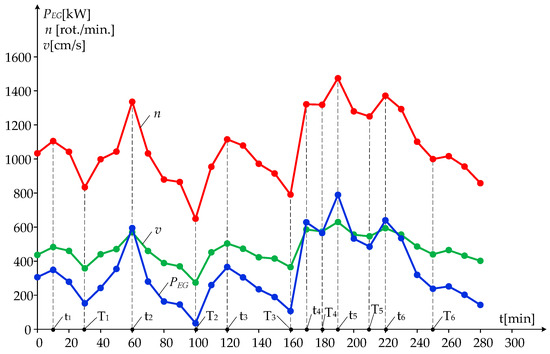
Figure 2.
The local extreme points of wind speed, rpm, and power at the generator.
In the following, the measured values of speed and power are compared with the optimal values derived from the mathematical model of the turbine, MM-WT [23], which have the form:
where kn is the proportionality factor for speed and kp is the proportionality factor for power.
ωOPTIM = kn ∙ v
PWT-MAX = kp ∙ v3
At these local extremes, the values of wind speed, speed, and power at the generator are the local maxima.
At t1 = 10 [min], v = 437 [cm/s], n = 1105.52 [rot/min], and PEG = 306.22 [kW],
n/v = 1105.52/437 = 2.5298
PWT = PEG/v3 = 306.22/4373 = 3.0999 · 10–6
Based on (10) and (11), and the values of wind speed, rotational speed, and supplied electric power, we computed the n/v ratio and the PWT for the 10 min intervals, shown in Table 2.

Table 2.
Values of n/V ratio and PWT power for maximum wind speed values.

Table 3.
Measured values of speed and power at local maxima.
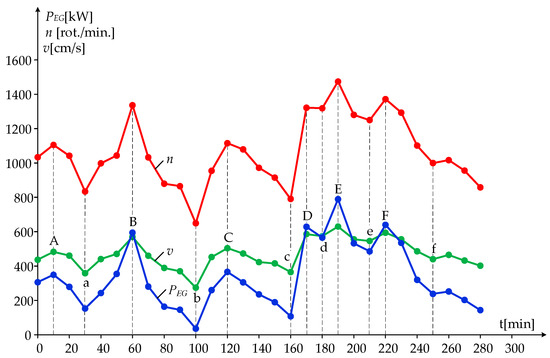
Figure 3.
Operating points at local highs and lows.
Figure 4 shows the dependence of power and speed on wind speed at the local maxima, with dash lines representing the interpolation of the measured points.
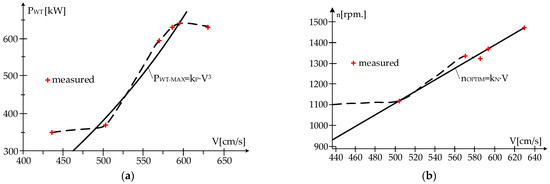
Figure 4.
Dependencies of (a) power and (b) rotation speed on wind speed at local maxima.
It can be seen from Figure 4 that for both the power and speed dependencies, the measured values sometimes differ significantly from those given by the functions: nOPTIM(v) and PWT–MAX(v).
The same problems arise for the case of the local minima.
At T1 = 30 [min], v = 358 [cm/s], n = 833.87 [rot/min], and PEG = 152.77 [kW],
n/v = 833.87/358 = 2.3292
PWT = PEG/v3 = 152.77/3583 = 3.3296 · 10–6
Similarly, we proceeded with the minimum wind speed values and calculated the n/v or PWT ratio, as shown in Table 4. Table 5 summarizes the values of speed and power at the local minimums.

Table 4.
n/v ratio and PWT power for minimum wind speed values.

Table 5.
Measured values of speed and power at local minima.
Figure 5 plots the calculated optimum values against the measured values as well as the interpolation of the measured points, highlighted with dash lines. From the MM-WT, the power and speed dependencies at the local minima are as follows:
n = kn ∙ v = 2.2976 ∙ v
PWT-MAX(v) = kP · v3 = 3.053 ∙ 10−6 ∙ v3
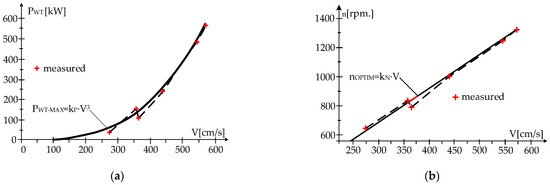
Figure 5.
Dependencies of (a) power and (b) rotation speed at local minima.
From the MM-WT, the power and speed dependencies at the local minima are
n = kn ∙ v = 2.2976 ∙ v
PWT-MAX(v) = kP · v3 = 3.053 ∙ 10−6 ∙ v3
In this case, too, the measured values are different from those resulting from the functions: nOPTIM(v) and PWT-MAX(v). The results obtained are valid only for a sampling step of 10 min, the value for which the design control was built.
4. Positioning of the Operating Points on the Power Characteristic
By positioning the operating points on the power characteristic, the PWT(ω,v) function, the WT operation is visualized in comparison to the maximum power points, MPPs. Given the graph of the power function, PWT(ω,v), with the maximum, MPP, at ωOPTIM, the operating points can be approximately located considering the values of the mechanical angular velocity and EG power.
The operating points are A, B, C, D, E, and F at times when the wind speed, speed, and generator power are at the local maxima (Figure 3). At times when v(t), n(t), and PWT(t) are at the local minima, the operating points are a, b, c, d, e, and f (Figure 3).
In the following, the measured values of speed and power are compared with the optimum values derived from the mathematical model of the turbine, MM-WT [37], which have the form:
nOPTIM = kn ∙ v
PWT-MAX = kP · v3
At these local extreme points, the values of the wind speed, speed, and power at the generator are the operating points A, B, C, D, E, and F at local highs, and a, b, c, d, e, and f, at local lows, which are, probably, in the MPP area (Figure 3).
The location of the operating points is approximate because the coordinates of the maximum power point (MPP) are not known with certainty and will change over time for wind systems operating at wind speeds that vary significantly over time. At the local maxima for the function nOPTIM(v), the operating points can be seen in Figure 6.
PWT(ω, 4.09) = 1453 ∙ 104 (4.09/ω − 2.6345 · 10−2) ∙ e−58.398(4.09/ω) ∙ 4.093
PWT(ω, 4.2828) = 1453 ∙ 104 (4.2828/ω − 2.6345 · 10−2) ∙ e−58.398(4.2828/ω) ∙ 4.28283

Figure 6.
Operating points at local maxima: (a) A and B; (b) C and D for nOPTIM (v) function.
Operating point A:
ωA = π ∙(1105.52/30) = 115.77 [rad./s.] PWT-A = 349.29 [kW]
For the other operating points, we proceeded in a similar way and the results are shown in Table 6.

Table 6.
Values for ω and PWT for operating points at local maxima.
The operating points E and F are not represented because they are not of interest, probably being the MPPs, since their speeds and powers may be the optimal values, nOPTIM and PWT–MAX.
Vc is 365 for point c and vb is 358 for point b. At the local minima, the operating points of interest are b and c, shown in Figure 7, because at c the rotational speed is lower than at b, though at c the wind speed is higher than that at b:
vc = 365 [cm/s] > vb = 358 [cm/s]
ωb = π ∙(833.87/30) = 87.32 [rad./s.] for point of function b
ωc = π ∙(791.02/30) = 82.835 [rad./s.] for point of function c
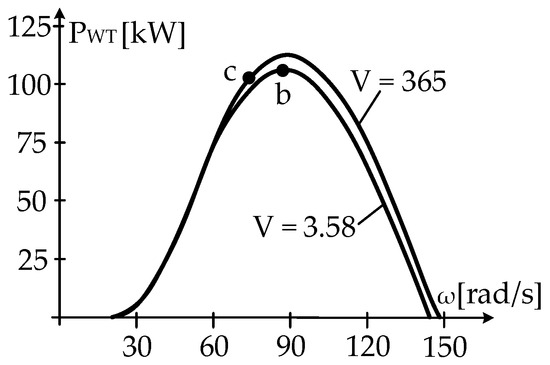
Figure 7.
Operating points at local highs and lows.
The positioning of the operating points was performed based on the coordinates of these points: ω (MAV) and power at the EG. The following conclusions can be drawn from the positioning of the operating points:
- Points B, D, E, F, and b can be MPPs, but this cannot be stated with certainty, as the exact coordinates of the points, ωOPTIM and PWT-MAX, are not known;
- Points A, C, and c cannot be MPPs, because their speeds are above the optimum values, nOPTIM;
- The dependence of the optimal wind turbine speed on the wind speed is not a linear function, nOPTIM = kV; as a result of the MM-WT, it depends on many factors;
- The MPP coordinates, ωOPTIM and PWT–MAX, can only be determined by running the WT in the area ∆ω = (0.9–1.1) · ωOPTIM, passing through the MPP.
The operating points E and F can be MPPs because their coordinates are
Point of operation E:
ωE = π ∙(1336.66/30) = 139.97 [rad/s] PWT-E = 594.43 [kW]
Point of operation F:
which are probably equal to the optimum, as illustrated in Figure 8.
ωF = π ∙(1474.47/30) = 154.41 [rad/s] PWT-F = 789.54 [kW]
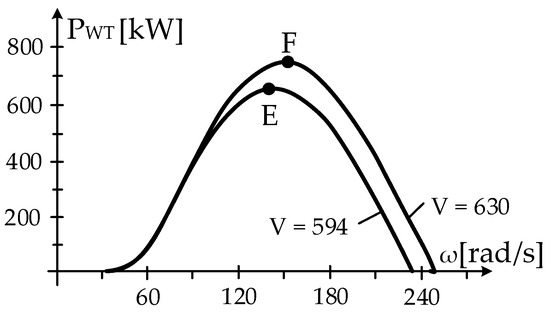
Figure 8.
Operating points at local maxima E and F.
Further, with regard to the WT power characteristic, the function PWT(ω) changes significantly with time and at varying wind speeds, and for high values of the equivalent moment of inertia J, it is difficult to determine the MPP coordinates. The results obtained are useful in determining the mathematical model for the WT.
5. Mathematical Model of the Turbine
Based on the time records of the fundamental parameters of wind speed, v, and rotational speed and power at the EG, the MM-WT can be determined; a model that is particularly important both for the optimal control of wind power plants and for the estimation of their performance under high temporal wind speed variations. The mathematical model for a WT at wind speed v is embodied in the WT power characteristic function, PWT(ω,v).
The maximum of the PWT(ω,v) function is at the point of maximum power, MPP (Figure 9), whose coordinate points are given by the optimum mechanical angular velocity, ωOPTIM, and the maximum power, PWT–MAX.
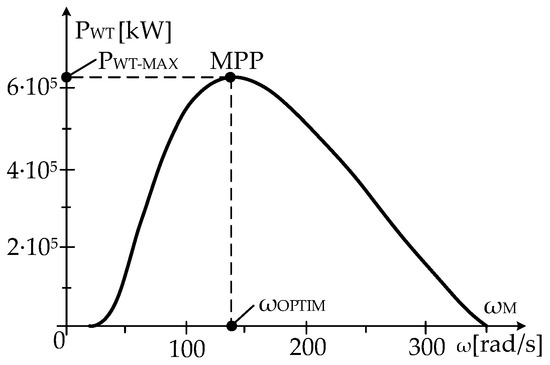
Figure 9.
WT power characteristic with maximum power point.
In the idle operation of the WT, the mechanical angular velocity has the maximum value, ωM. In the control design, the MPP area and knowledge of the dependence of the optimal mechanical angular velocity, ωOPTIM, on the wind speed are essential. This fundamental problem is addressed in this paper.
This MM-WT can be updated in real-time to ensure maximum wind energy capture. The mathematical model of the wind turbine determines the optimum speed as a function of the wind speed. Various forms of the WT power curve, the PWT(ω,v) function, have been given in the literature [18,19,20,21,22,23,31].
The most useful case is that with three parameters– a, b, and c—with the form:
PWT(ω,v) = a[(v/ω) − b] · e−c(v/ω) ·v3
Parameters a, b, and c are determined by measuring the following: the wind speed, v, the power flow, PEG, and the rotation speed/mechanical angular velocity at EG, n/ω.
The coordinates of the maximum power points, MPPs, are obtained from
or
with the solution
and maximum power:
dPWT/dω = 0
d {[(v/ω) − b/]·e−c(V/ω)}/dω = −(v/ω3) · e−V·(c/ω) · (ω − v · c + b · c · ω) = 0
ωOPTIM = v · c/[ (b · c) + 1]
PWT-MAX = a · {(1/c) · [(b · c) + 1] − b} · e−c·{(1/c) · [(b · c)+1]} ·v3 = v3 · (a/c) · e−bc−1
The maximum value of VUM, ωM, is at PWT = 0, resulting in
(v/ωM) − b = 0, and ωM = v/b
It is known from the literature [18,19,20,23,36,37] that the value of the ratio ωOPTIM/ωM is
which gives the value of the product b · c:
(ωOPTIM/ωM) = {(v · c)/[(b · c) + 1]}/(v/b) = (b · c)/[(b · c) + 1] = 0.4
b · c = 0.66667
With this value we obtain
PWT-MAX = v3 · (a/c) · e−bc−1 = 0.18887 · (a/c) · v3
At operating points B, D, E, F, and b, which can be MPPs, the values of the ratios a/c = x are
Point of function C, 365.84 = 0.18887 · x · 5.043 with solution 15.13
Point of function D, 628.65 = 0.18887 · x · 5.863 with solution 16.541
Point of function E, 789.54 = 0.18887 · x · 6.33 with solution 13.34
Point of function F, 639.87 = 0.18887 · x · 5.943 with solution 16.165
Point of function a, 152.77 = 0.18887 · x · 3.583 with solution 17.629
When operating in an MPP, the values of the a/c reports should be the same, but, if they are not equal at those points, the captured wind energy is not at a maximum and, hence, some operating points are not MPPs.
5.1. First Case Study
For the determination of the MM-WT, the operating point D is chosen as the MPP, although this cannot be stated with certainty, as the coordinates of this point are not known exactly.
At operating point D, the wind speed, speed, and power have values of v = 586 [cm/s], n = 1321.75 [rot/min], and PEG = 628.65 [kW], from which it follows that
and we obtain
ωD = (π/30) · 1321.75 = 138.41 [rad/s]
PWT/v3 = 628,650/5.863 = 0.18887 · (a/c)
a/c = 16,540, or a = 16,540 · c
With this data, the WT power characteristic, the function PWT (ω, v), becomes
PWT(ω, 5.86) = a · [(v/ω) − b] · e−c(v/ω) · v3
PWT(ω, 5.86) = 16,540 · c [(5.86/138.41) − b] · e−c(5.86/138.41) · 5.863
62,850 = 16,540 · (4.2338 · 10−2 · c −0.66667) · e−c(5.86/138.41) · 5.863
From this equation, the parameter c is determined as follows:
ec(5.86/138.41) = [16,540 · (4.2338 · 10−2 · c − 0.66667) · 5.863]/628,650
The value of parameter c is obtained from the intersection of the two graphs (Figure 10) and is c = 39.5.
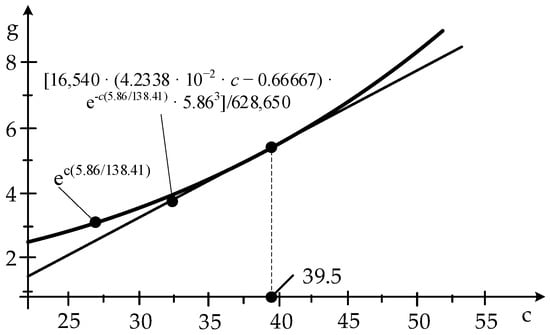
Figure 10.
Determining the parameter c.
From bc follows the value of parameter b:
b = bc/c = 0.66667/39.5 = 1.6878 · 10−2
When a/c = 16,540, this results in a value of parameter a of
and, thus, the WT power characteristic, the function PWT(ω, 5.86), or the MM-WT, is obtained in the form:
a = 16,540 · c = 16,540 · 39.5 = 6.5333 · 105
PWT(ω, 5.86) = a[(v/ω) − b]· e−c(v/ω) · v3
PWT(ω, 5.86) = 6.5333·105 (5.86/ω − 1.6878·10−2) · e−39.5(5.86/ω) · 5.863
The mathematical model of a WT at wind speed v is expressed as follows:
PWT(ω, v) = 6.5333·105(v/ω − 1.6878·10−2) · e−39.5(v/ω) · v3
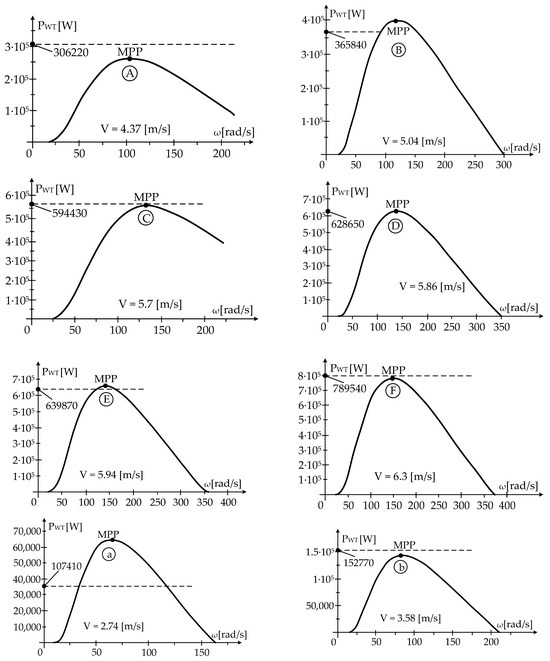
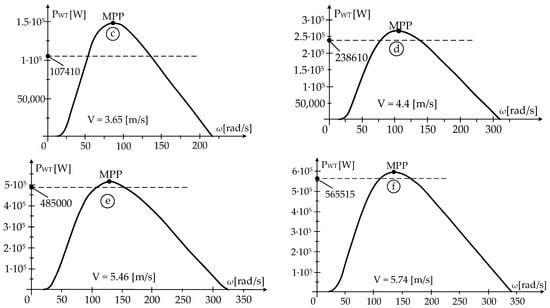
Figure 11.
WT power characteristics at different wind speed values: PWT[W]—wind turbine power; ω[rad/s]—mechanical angular velocity at electric generator shaft; v[m/s]—wind speed; MPP—maximum power point of WT.
From the analysis of the WT power characteristics given above, it appears that there are large differences between the measured and the corresponding MPPs, PWT–MAX.
At operating points A, C, and b, a paradoxical situation occurs: the power given by the WT is higher than the maximum value, PWT–MAX, which invalidates the MM-WT deduced from the data at operating point D. It seems that the MM-WT cannot be applied over the whole range of wind speeds, because in the low-speed range
and large differences occur between the measured powers and the corresponding MPPs, compared to the area of higher speeds
where the differences in power are smaller.
v = (2.74 … 3.65) [m/s]
v = (5.4 … 6.3) [m/s]
To eliminate this paradoxical situation at operating point A, the MM-WT is recalculated.
5.2. Recalculation of MM-WT
The MM-WT recalculation is performed with data from operating point—A—MM-WT-recalculated-1.
At operating point A, the wind speed, speed, and power have values of v = 437 [cm/s], n = 1033.33 [rot/min], and PEG = 306,220 [W], from which it follows that
and we obtain
ωA = (π/30) · 1033.33 = 115.77 [rad/s]
PWT/v3 = 306,220/4.373 = 3669.4 = 0.18887 · (a/c)
a/c = 9428, or a = 19,428 · c
With this data, the WT power characteristic, the function PWT (ω, v), becomes
PWT(ω, 4.37) = a[(v/ω) − b] · e−c(v/ω) · v3
PWT(ω, 4.37) = 19,428 · c (4.37/108.21 − b) · e−c(4.37/108.21) · 4.373
306,220 = 19,428 · (4.0384 · 10−2 · c − 0.66667) · e−c(4.0384 · 10−2) · 4.373
From this equation, the parameter c is determined as follows:
ec(4.0384 · 10−2) = [19,428 · (4.0384· 10−2 · c − 0.66667) · 4.373]/306,220
The value of parameter c is obtained from the intersection of the two graphs (Figure 12) and is c = 41.5.
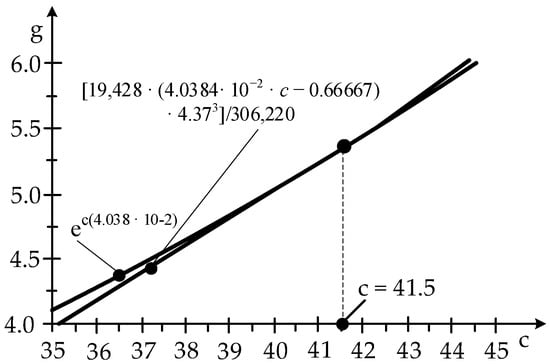
Figure 12.
Determination of parameter c for MM-WT-recalculated—1.
From bc results the value of parameter b:
b = bc/c = 0.66667/41.5 = 1.6064 · 10−2
When a/c = 19,428, this results in a value of parameter a of
and, thus, the WT power characteristic, the function PWT(ω, 4.37), or the MM-WT-recalculated-1, has the form:
a = 19,428 · c = 19,428 · 41.5 = 8.0626 · 105
PWT(ω, 4.37) = a[(v/ω) − b]· e−c(v/ω) · v3
PWT(ω, 4.37) = 8.0626 · 105 (4.37/ω − 1.6064·10−2) · e−41.5(4.37/ω) · 4.373
With this form of the MM-WT, operating point—A becomes the MPP, as shown in Figure 13.

Figure 13.
WT power characteristics from operating point—A.
This form of the MM-WT, derived from the data from operating point A, is closer to reality, but it cannot be said with certainty that operating point A is the MPP. It can, however, be stated with certainty that the operating points B, D, a, c, d, e, and f in Figure 11 are not the MPP. Other points could be chosen, apart from operating point A, for the MM-WT deduction, but these points, however, must have a measured power value, PWT-MES, greater than or equal to the maximum, PWT–MAX:
PWT-MES > PWT-MAX
The mathematical model of the WT, recalculated at wind speed v, is as follows:
PWT(ω,v) = 5.97144 · 105(v/ω − 1.6064 · 10−2)e−41.5(v/ω) · v3
5.3. Comparison of the Two MM-WTs
Comparing these two MM-WTs, it can be seen from Figure 14 that the calculated MM-WT operating point B is further away from the MPP than that in the original MM-WT.
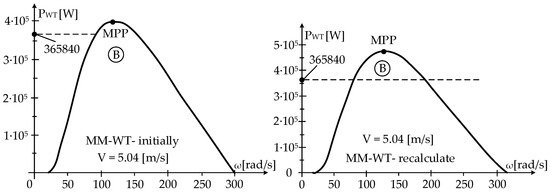
Figure 14.
The WT power characteristics for the two MM-WTs at operating point B.
Not only by comparing the WT power characteristics graphs, shown in Figure 14, can one assert this, but also by calculations based on the previous results:
- With MM-WT-initial:
PWT-MAX = 0.18887 · 16,540 · v3 = 3123.91 · v3
- With MM-WT-recalculated-1:
PWT-MAX = 0.18887 · 19,428 · v3 = 3669.4 · v3
At operating point B, the wind speed has a value v = 5.04 [m/s], and we obtain the following:
- With MM-WT-initial:
PWT-MAX-INITIAL = 3123.9 · 5.043 = 3.9993 · 105 [W]
- With MM-WT-recalculated-1:
PWT-MAX-RECALCULATED-1 = 3669.4 · 5.043 = 4.6977 · 105 [W]
The power differences between the maximum values, calculated as the follow-ups PWT–MAX–INITIAL and PWT–MAX–RECALCULATED–1, and the measured value at operating point B, PWT-MES-B = 365,840 [W], are as follows:
- With MM-WT-initial:
ΔPWT-INITIAL = PWT-MAX-INITIAL − PWT-MES-B = 3.9993 · 105 − 365,840 = 34,090 [W]
- With MM-TV-recalculated-1:
ΔPWT-RECALCULATED = PWT-MAX-RECALCULATED − PWT-MAS-B = 4.6977·105 − 365,840
ΔPWT-RECALCULATED = 1.0393 · 105 [W]
So, this calculation also confirms that B is not an operating point in the MPP. The power loss at operating point B is large:
ΔP = (ΔPWT-RECALCULATED/PWT-MAX-RECALCULATED-1) ·100
ΔP = (1.0393 · 105/4.6977 · 105) · 100 = 22.124%
This form of the MM-WT, deduced based on data from operating point A, is closer to reality, but it cannot be stated with certainty that operating point A is the MPP. It can be stated with certainty that operating points C, D, a, c, d, e, and f in Figure 11 are not the MPP. A, for the MM-WT deduction, has points which, however, must have a measured power value, PWT-MES, greater than or equal to the maximum, PWT–MAX:
PWT-MES ≥ PWT-MAX
5.4. The MM-WT Recalculation in the Low-Speed Zone
In the range of low wind speeds, 3 [m/s], where the differences between the performances are large, a recalculation of the MM-WT is also required. The MM-WT recalculation is performed with data from operating point b MM-WT-recalculated-2. At operating point b, the wind speed, speed, and power have values of v = 3.58 [m/s], n = 833.87 [rot/min], and PEG = 152,770 [W], from which it follows that
and we obtain
ωb = (π/30) · 833.87 = 87.323 [rad/s]
PWT/v3 = 152,770/3.583 = 33,296 = 18,887 · (a/c)
a/c = 17,629, or a = 17,629 · c
The WT power feature becomes
PWT(ω, 4.37) = a[(v/ω) − b] · e−c(v/ω) · v3
PWT(ω, 4.37) = 17,629 · c (3.58/87.323 − b) · e−c(3.58/87.32321) · 3.583
152,770 = 17,629 · (4.0997 · 10−2 · c − 0.66667) · e−c(3.58/87.32321) · 3.583
From this equation, the parameter c is determined by
according to the two graphs in Figure 15, resulting in c = 41.
152,770 · e c(4.0997·10−2) = 17,629 · (4.0997 · 10−2 · c − 0.66667) · 3.583
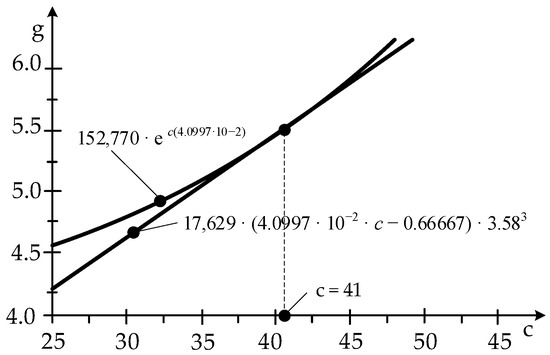
Figure 15.
Value of parameter c at MM-WT-recalculated—2.
From b · c results the value of parameter b:
b = bc/c = 0.66667/41 = 0.01626
When a/c = 17,629, this results in a value of parameter a of
and, thus, the WT power characteristic, the function PWT (ω, 3.58), or the MM-WT-recalculated-2, has the form:
a = 17,629 · c = 17,629 · 41 = 7.2279 · 105
PWT(ω, 3.58) = a[(v/ω) − b]· e−c(v/ω) · v3
PWT(ω, 3.58) = 7.2279 · 105 (3.58/ω − 0.01626) · e−41(3.58/ω) · 3.583
The mathematical model of the WT at wind speed v is expressed as follows:
PWT(ω, v) = 7.2279 · 105 (v/ω − 0.01626) · e−41(v/ω) · v3
Operating point b, with this form of the MM-WT, becomes the MPP (Figure 16).

Figure 16.
Power characteristics at operating point b.
Further analyzing operating point-a, it can be seen from Figure 17 that the power difference between the measured value, PWT-MES-a, and the maximum value, PWT–MAX, is increased in the MM-WT-recalculated-2 version compared to the MM-WT-initial. At operating point-a-, the wind speed has a value v = 2.74 [m/s]. Operating point a is further away from the MPP in the MM-WT-recalculated-2 version.

Figure 17.
The operating point a with the two power characteristics.
This can also be stated by calculations, as follows:
- With MM-WT-initial:
PWT-MAX-INITIAL = 0.18887 · 16,540 · v3 = 3123.9 · v3 = 3123.9 · 2.743 = 64,261 [W]
- With MM-WT-recalculated-2:
PWT-MAX-RECALCULATED-2 = 0.18887·17,629 · v3 = 3329.6 · v3 = 3329.6 · 2.743 = 68,493 [W]
The power differences between the maximum values, PWT–MAX– INITIAL and PWT–MAX– RECALCULATED–2, and the measured value at operating point a are PWT-MES-a = 35,670 [W]. This can also be expressed as follows:
- With MM-WT-initial:
ΔPWT-INITIAL = PWT-MAX-INITIAL − PWT-MES-a = 64,261 − 35,670 = 28,521 [W]
- With MM-WT-recalculated:
ΔPWT-RECALCULATED = PWT-MAX-RECALCULATED-2 − PWT-MES-a = 68,493 − 35,670 = 32,823 [W]
It is confirmed that operating point a not is the MPP. The power loss, ∆P, at operating point a is very high:
ΔP = (ΔPWT-RECALCULATED/PWT-MAX-RECALCULATED-2) · 100
ΔP = (32,823/68,493) ·100 ≈ 48%
In reality, at the point of operation, the power loss is higher and can exceed 50%, so only half of the wind energy is captured that could be captured at MPP operation, at aOPTIM. With this data, an algorithm can be constructed to determine the power losses occurring in wind power systems operating at time-varying wind speeds.
6. Algorithm for Determining Power Losses
The algorithm for visualizing the optimal energy zone consists of four steps. The first step is to collect the experimental data by recording the wind speed, power, and generator speed. In the second step, the time moments, tks, at which the speed, the function ω(t), has local extremes are identified and the turbine power is calculated. The third step is to extract from the experimental data the values for wind speed (v1), and optimal MAV (ωOPTIM), at time tk. Finally, in step four, the conclusions about the power losses at the analyzed operating points are mentioned.
- Step 1—in the first step, the functions generated are the wind speed, v(t), mechanical angular speed, ω(t), power at EG, PEG(t), presented in Figure 18;
- Step 2—in the second step, the time moments, tks, are identified at which the speed, the function ω(t), has local extremes, presented in Figure 19;
- Step 3—in the third step, the PWT(ω) functions are displayed for the WT power characteristics, with the operating points defined by the local speed extremes (e.g., A and B), presented in Figure 20;
- Step 4—finally, in step four, conclusions are drawn about the energy efficiency of the operating points.
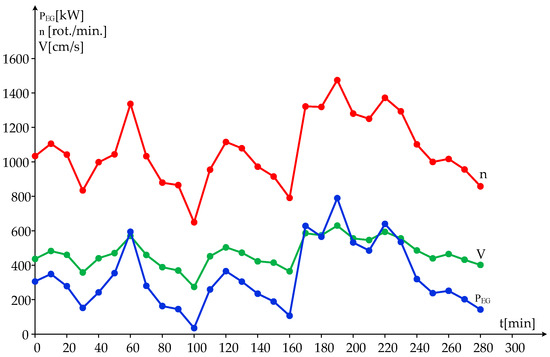
Figure 18.
Time variation in wind speed, rotation speed, and power of electric generator.
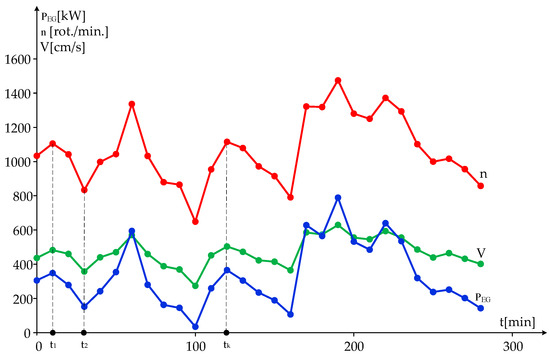
Figure 19.
Identification of local speed extremes.
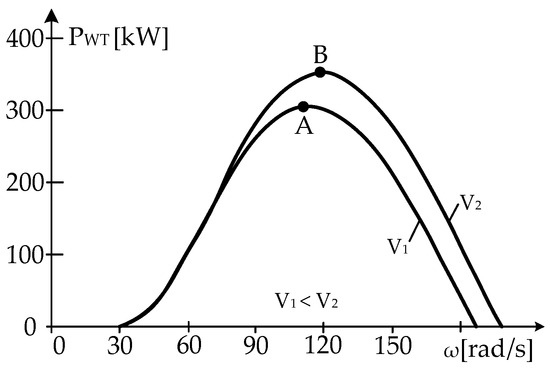
Figure 20.
Operating points defined by local extremes A and B.
For example, only one of the following conclusions about the energy efficiency at the point of operation may be true:
- In A, the energy efficiency is lower than in B;
- In A, no maximum wind energy is captured;
- Point B may be the point of maximum power.
Figure 21 shows the algorithm used to determine the loss of power.
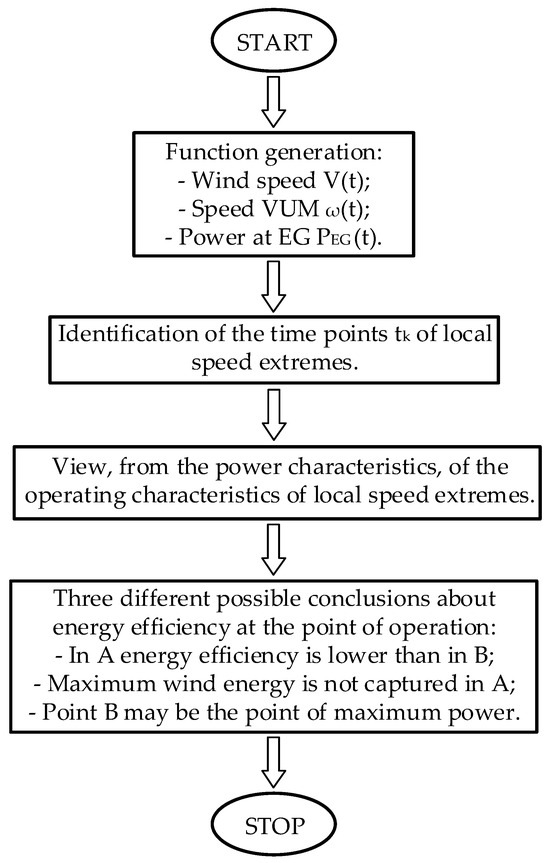
Figure 21.
Algorithm for determining power losses.
7. Discussion of the Findings
7.1. Operating Results
The results of this study are as follows:
- The local extremes of the speed, or the function ω(t), are obtained simply by recording the speed over time at a sampling step, ∆t, dependent on the value of the speed derivative of the wind, dv/dt, and the value of the moment of inertia, J;
- For the design of the control system, it is essential to know the exact dependence of the optimal MAV, ωOPTIM, on the wind speed, v. This is easily determined from the mathematical model of the WT;
- The results obtained are used to determine the mathematical model of the WT, a useful model in control design;
- The visualization of the operating points makes it possible to estimate the power losses due to the incorrect value of the reference variable, ωOPTIM, in the control system;
- In reality, the power losses are higher than the calculated ones, more than 48% (the value previously obtained from the existing experimental data). In the calculations, some operating points are considered as MPPs, which cannot be verified due to the lack of a wider range of speed values at the same wind speed value;
- On the power function graph, PWT(ω, v), the operating points are located, and compared to the maximum power points, MPPs.
7.2. Fundamental Aspects
Through this study, the following relevant aspects can be highlighted:
- The certain aspects are as follows:
- Determining the turbine power, PWT, from equality with the power at the electric generator shaft, PEG, at the local extreme points of the MAV, for the function ω(t);
- At some operating points, the maximum wind energy is not captured, as shown in the experimental data by comparing the WT power values;
- At the local extremes of mechanical angular velocity (MAV), for the function ω(t), the turbine power at the shaft is equal to the electric generator power at the shaft.
- The uncertain issues are as follows:
- One of the operating points can be the MPP and it can capture the maximum primary wind energy;
- But it is not known whether the range of speed values (MAV) contains the optimum zone (0.9–1.1)ωOPTIM, including the MPP;
- At the local extreme points of speed (MAV), for the function ω(t), it is possible that the speeds are equal to the optimal values.
7.3. Main Parameters and Selection Criteria
The analysis of the operating points defined by the local extremes of speed is characterized by the following:
- 1.
- The zero value of the derivative of the mechanical angular velocity, dω/dt;
- 2.
- The simplified form of the momentum equation
J · (dω/dt) = 0 = MWT − MEG
- 3.
- The WT’s power equality with the EG in dynamic mode
J · (dω/dt) · ω = 0 = PWT − PEG; PWT = PEG
- 4.
- It is not necessary to know the value of the equivalent moment of inertia, J, as the power given by the WT is equal to the power from the EG (which is obtained from the power delivered to the grid by dividing by the EG efficiency value).
The method presented provides the basis for a control system with reference measurements updated in real-time, which is particularly useful for capturing maximum wind energy, a method that does not exist in the literature.
In control design, the use of an incorrect value for the reference variable no longer ensures operation in the optimal MPP range, which is defined by the correct values for the reference variable to ensure the operation of the wind turbines in the MPP range.
The optimal parameter values are visualized during the operation of the wind turbine.
For a clear view of the maximum power, the initial prescribed value of the generator power, PEG, must be much lower than the maximum value of the WT power, PMAX, and the value of the wind speed at the initial time, v0.
In physical systems with fixed power maxima over time (e.g., wind power systems operating at v = const.), it is not necessary to know the exact dependence of the optimal MAV, ωOPTIM, on the wind speed and the Perturb and Observe Method, POM, can be applied.
In wind power systems operating at time-varying wind speeds, v ≠ const, the optimal MAV value changes over time, and due to the large mechanical inertia (large moment of inertia) the POM cannot be applied.
To obtain the most accurate view of the local extremes of the speed, the value of the sampling step, ∆t, should be as small as possible.
In conclusion, by estimating the wind speed and speed values at the electrical generator at a well-defined sampling step, ∆t, and at an initial MAV value, ω(0), below the optimal MAV value corresponding to the wind speed, the maximum power point of the WT can be identified.
In the present paper, the authors analyzed the variation in the wind speed at a wind turbine—a GE 2.5 MW 100— at Galbiori in the Dobrogea area, for which they recalculated the mathematical model based on the experimental data. Also, the dependence of the optimal mechanical angular speed on the wind speed—a reference quantity in the WT control system—was computed to achieve maximum wind energy capture. The optimal mechanical angular velocity was determined in the context of the dependence between maximum power and wind speed, and their time variations were compared with the real ones. The operating points resulting from the measurements were positioned on the power characteristics of the wind turbine and compared with those corresponding to the maximum power points, demonstrating that in most cases, the WT does not operate in the maximum power points.
8. Conclusions
In this paper, the local speed extremes were identified, and it was shown that in most cases, wind turbines do not achieve maximum power point tracking. By visualizing the operating points on the WT power curve, the resulting power losses were estimated. A control method with reference variables updated in real-time was presented, a method that does not exist in the literature. The results obtained are based on experimental data from wind turbines on the Romanian Black Sea coast—the Dobrogea area.
The research in this field is characterized by many gaps, such as a lack of relevant works aimed at determining the dependence of the optimal mechanical angular speed on the wind speed, and data from the technical book of wind turbines, having differences in time in operation, require a recalculation of the mathematical model based on measurements from where it operates. The aim of the research in this work was precisely to eliminate these gaps, in the sense that the power conversion coefficient must always be recalculated over time because the initial conditions have changed; the ratio λ, the ratio between the speed of the ends of the blades and the speed of the wind, a reference quantity in the control system, always has to be recalculated.
By analyzing the time variations in the MAV, the extreme points of the ω(t) function could be identified. For these local extremes, the derivative of the mechanical angular velocity is zero, dω/dt = 0, and the WT power in the dynamic mode at these operating points is equal to the power from the electric generator, PWT = PEG. The operating points, positioned on the WT power characteristics, were compared with those corresponding to the maximum power points. Future research should ensure that wind turbines operate at their optimum mechanical angular velocity, at the maximum power point of the turbine, by varying the load on the electrical generator as a function of wind speed. Thus, based on the experimental data, maximum wind energy capture can be achieved even with variable wind speeds over time. Furthermore, the visualization of the optimal area from an energy point of view, to locate the operating points of the WT compared to the maximum power point, allows for a much more precise determination of the energy yield. Additionally, a reliable mathematical representation of the turbine was established, and adjusted using data collected from the operational wind turbine, a model that underwent experimental validation. Moreover, a comparison of the optimal mechanical angular speed and the current mechanical angular speed was also visualized.
Author Contributions
Conceptualization, C.P.C. and G.-O.T.; methodology, C.P.C. and E.S.; software, C.P.C.; validation, C.P.C. and E.S.; formal analysis, E.S.; investigation, C.P.C. and G.-O.T.; resources, C.P.C. and E.S.; data curation, G.-O.T.; writing—original draft preparation, C.P.C.; writing—review and editing, E.S.; visualization, C.P.C. and E.S.; supervision, C.P.C.; project administration, C.P.C. and E.S.; funding acquisition, C.P.C. and E.S. All authors have read and agreed to the published version of the manuscript.
Funding
The publication of this article was supported by the 2023 Development Fund of the UBB.
Institutional Review Board Statement
Not applicable.
Informed Consent Statement
Not applicable.
Data Availability Statement
Data are contained within the article.
Conflicts of Interest
The authors declare no conflicts of interest. The funders had no role in the design of the study; in the collection, analyses, or interpretation of data; in the writing of the manuscript, or in the decision to publish the results.
Symbols and Abbreviations
| Symbol/Abbreviation | Meaning |
| v | wind speed |
| n | rotational speed |
| PEG | power at the electric generator |
| PWT | power of wind turbine |
| ω | mechanical angular velocity |
| ωOPTIM | optimum mechanical angular velocity |
| J | inertia moment |
| ∆P | power loss |
| MEG | electromagnetic torque given by electric generator |
| kn | the proportionality factor for speed |
| kp | the proportionality factor for power |
| WT | wind turbine |
| MAV | mechanical angular velocity |
| MM-WT | mathematic model—wind turbine |
| EG | electric generator |
| MPP | maximum power point |
| POM | perturb and observe method |
| DFIG | double-fed induction generators |
References
- Wickramasinghe, A.; Meegahapola, L.; Agalgaonkar, A.P.; Perera, S. Dispatch Strategy to Minimise Uncertainty in Wind Power Generation in the Australian National Electricity Market. In Proceedings of the Australasian Universities Power Engineering Conference (AUPEC), Perth, Australia, 28 September–1 October 2014. [Google Scholar]
- Spudic, V.; Jelavic, M.; Baotic, M. Wind Turbine Power References in Coordinated Control of Wind Farms. Automatika 2011, 52, 82–94. [Google Scholar] [CrossRef]
- de Andrade, A.R.; Melo, V.F.M.B.; Lucena, D.B.; Abrahao, R. Wind speed trends and the potential of electricity generation at new wind power plants in Northeast Brazil. J. Braz. Soc. Mech. Sci. Eng. 2021, 43, 182. [Google Scholar] [CrossRef]
- Franco, I.; Gutierrez, A.; Cataldo, J. An approach to model extreme wind speed distributions using the Weather Research and Forecasting model. Wind Eng. 2020, 44, 341–360. [Google Scholar] [CrossRef]
- Neelamani, S.; Al-Awadhi, L.; Al-Ragum, A.; Al-Sudairawi, M. Extreme wind speed from different directions in Kuwait. Wind. Eng. 2007, 31, 139–148. [Google Scholar] [CrossRef]
- Li, P.F.; Zhang, Q.; Song, Y.L.; Zhang, Y.C. The Technical to Realize Variable Speed Constant Frequency Operation of Large Wind Turbine Generator. In Proceedings of the International Conference on Mechanical, Electronic and Information Technology (ICMEIT), Shanghai, China, 15–16 April 2018. [Google Scholar]
- Xingjia, Y.; Yingming, L.; Jieqiu, B.; Zuoxia, X. Research and simulation of direct drive wind turbine VSCF characteristic. In Proceedings of the 2008 IEEE International Conference on Automation and Logistics, Qingdao, China, 1–3 September 2008. [Google Scholar]
- Carstea, C.; Butaru, F.; Ancuti, M.-C.; Musuroi, S.; Deacu, A.; Babaita, M.; Stanciu, A.M. Wind Power Plants Operation at Variable Wind Speeds. In Proceedings of the 2020 IEEE 14th International Symposium on Applied Computational Intelligence and Informatics (SACI), Timisoara, Romania, 21–23 May 2020. [Google Scholar]
- Mérida, J.; Aguilar, L.T.; Dávila, J. Analysis and synthesis of sliding mode control for large scale variable speed wind turbine for power optimization. Renew. Energ. 2014, 71, 715–728. [Google Scholar] [CrossRef]
- Magar, K.T.; Balas, M.J. Modeling and Direct Adaptive Control of Utility-Scale Wind Turbines for both Onshore and Offshore Operation. In Proceedings of the 8th Annual IEEE Systems Conference (SysCon), Ottawa, ON, Canada, 31 March–3 April 2014. [Google Scholar]
- Fan, X.; Crisostomi, E.; Zhang, B.; Thomopulos, D. Rotor Speed Fluctuation Analysis for Rapid De-Loading of Variable Speed Wind Turbines. In Proceedings of the 2020 IEEE 20th Mediterranean Electrotechnical Conference (MELECON), Palermo, Italy, 16–18 June 2020. [Google Scholar]
- Menezes, E.J.N.; Araújo, A.M.; Rohatgi, J.S.; del Foyo, P.M.G. Active load control of large wind turbines using state-space methods and disturbance accommodating control. Energy 2018, 150, 310–319. [Google Scholar] [CrossRef]
- Michalke, G.; Hansen, A.D. Modelling and control of variable speed wind turbines for power system studies. Wind. Energy 2010, 13, 307–322. [Google Scholar] [CrossRef]
- Stock, A.; Leithead, W. A generic approach to wind farm control and the power adjusting controller. Wind. Energy 2022, 25, 1735–1757. [Google Scholar] [CrossRef]
- Edrah, M.; Zhao, X.; Hung, W.; Qi, P.; Marshall, B.; Karcanias, A.; Baloch, S. Effects of POD Control on a DFIG Wind Turbine Structural System. IEEE T Energy Conver. 2020, 35, 765–774. [Google Scholar] [CrossRef]
- Qiao, W.; Gong, X.A.; Qu, L.Y. Output Maximization Control for DFIG Wind Turbines without Using Wind and Shaft Speed Measurements. IEEE Energy Convers. Congr. Expo. 2009, 1, 404–410. [Google Scholar]
- Hosseinzadeh, M.; Salmasi, F.R. Analysis and detection of a wind system failure in a micro-grid. J. Renew. Sustain. Energy 2016, 8, 043302. [Google Scholar] [CrossRef]
- Deng, X.F.; Yang, J.; Sun, Y.; Song, D.R.; Yang, Y.G.; Joo, Y.H. An Effective Wind Speed Estimation Based Extended Optimal Torque Control for Maximum Wind Energy Capture. IEEE-Inst. Electr. Electron. Eng. Inc. 2020, 8, 65959–65969. [Google Scholar] [CrossRef]
- Babescu, M. Synchronous Machine: Modelling-Identification-Simulation; Polityehnica Publishing House: Timisoara, Romania, 2003. [Google Scholar]
- Karthik, R.; Hari, A.S.; Kumar, Y.V.P.; Pradeep, D.J. Modelling and Control Design for Variable Speed Wind Turbine Energy System. In Proceedings of the International Conference on Artificial Intelligence and Signal Processing (AISP), Amaravati, India, 10–12 January 2020; VIT AP Univ: Andhra Pradesh, India, 2020. [Google Scholar]
- Rebello, E.; Watson, D.; Rodgers, M. Performance Analysis of a 10 MW Wind Farm in Providing Secondary Frequency Regulation: Experimental Aspects. IEEE-Inst. Electr. Electron. Eng. Inc. 2019, 34, 3090–3097. [Google Scholar] [CrossRef]
- Sudharsan, G.S.; Vishnupriyan, J.; Anand, K.V. Active flow control in Horizontal Axis Wind Turbine using PI-R controllers. In Proceedings of the 6th International Conference on Advanced Computing and Communication Systems (ICACCS), Coimbatore, India, 6–7 March 2020. [Google Scholar]
- Sorandaru, C.; Musuroi, S.; Frigura-Iliasa, F.M.; Vatau, D.; Dordescu, D. Analysis of the Wind System Operation in the Optimal Energetic Area at Variable Wind Speed over Time. Sustainability 2019, 11, 1249. [Google Scholar] [CrossRef]
- Chioncel, C.-P.; Spunei, E.; Tirian, O.-G. Influence of the Wind Speed Amplitude on the Energy Captured by a Wind Turbine Operating at Time-Varying Wind Speeds. In Proceedings of the 2023 International Conference on Electromechanical and Energy Systems (SIELMEN), Craiova, Romania, 11–13 October 2023. [Google Scholar]
- Hussain, J.; Mishra, M.K. An Efficient Wind Speed Computation Method Using Sliding Mode Observers in Wind Energy Conversion System Control Applications. IEEE Trans. Ind. Appl. IEEE T. IND. APPL. 2019, 56, 730–739. [Google Scholar] [CrossRef]
- Goyal, S.; Maurya, S.K.; Kumar, S.; Agarwal, D. A Consolidation Review of Major Wind Turbine Models in Global Market. In Proceedings of the 2020 International Conference on Power Electronics & IoT Applications in Renewable Energy and Its Control (PARC), Mathura, India, 28–29 February 2020. [Google Scholar]
- Baala, Y.; Bri, S. DFIG-Based Wind Turbine Control Using High-Gain Observer. In Proceedings of the 2020 1st International Conference on Innovative Research in Applied Science, Engineering and Technology (IRASET), Meknes, Morocco, 16–19 April 2020. [Google Scholar]
- Najih, Y.; Adar, M.; Aboulouard, A.; Khaouch, Z.; Bengourram, M.; Zekraoui, M.; Mabrouki, M. Mechatronic Control Model of a Novel Variable Speed Wind Turbine Concept with Power Splitting Drive Train: A Bond Graph Approach. In Proceedings of the 2020 IEEE 6th International Conference on Optimization and Applications (ICOA), Beni Mellal, Morocco, 20–21 April 2020. [Google Scholar]
- Vadi, S.; Gürbüz, F.B.; Bayindir, R.; Hossain, E. Design and Simulation of a Grid Connected Wind Turbine with Permanent Magnet Synchronous Generator. In Proceedings of the 8th International Conference on Smart Grid (icSmartGrid), Paris, France, 17–19 June 2020. [Google Scholar]
- An, Y.Y.; Li, Y.G.; Zhang, J.; Wang, T.; Liu, C.F. Enhanced Frequency Regulation Strategy for Wind Turbines Based on Over-speed De-loading Control. In Proceedings of the 5th Asia Conference on Power and Electrical Engineering (ACPEE), Chengdu, China, 4–7 June 2020. [Google Scholar]
- Dobrin, E.; Ancuti, M.C.; Musuroi, S.; Sorandaru, C.; Ancuti, R.; Lazar, M.A. Dynamics of the Wind Power Plants at Small Wind Speeds. In Proceedings of the IEEE 14th International Symposium on Applied Computational Intelligence and Informatics (SACI), Timisoara, Romania, 21–23 May 2020. [Google Scholar]
- Huynh, P.; Tungare, S.; Banerjee, A. Maximum Power Point Tracking for Wind Turbine Using Integrated Generator-Rectifier Systems. IEEE-Inst. Electr. Electron. Eng. Inc. 2021, 36, 504–512. [Google Scholar] [CrossRef]
- GE Ships Its 1000th 2.5 MW Wind Turbine to Wind Farm Project in Romania. Available online: https://www.romania-insider.com/ge-ships-its-1000th-2-5-mw-wind-turbine-to-wind-farm-project-in-romania (accessed on 20 June 2022).
- Chen, P.; Han, D.; Tan, F.; Wang, J. Reinforcement-Based Robust Variable Pitch Control of Wind Turbines. IEEE-Inst. Electr. Electron. Eng. Inc. 2020, 8, 20493–20502. [Google Scholar] [CrossRef]
- Chioncel, C.-P.; Spunei, E.; Tirian, O.-G. Optimizing Energy Production for Wind Turbines Operating in Variable Wind Speed Conditions. In Proceedings of the 2023 International Conference on Electromechanical and Energy Systems (SIELMEN), Craiova, Romania, 11–13 October 2023. [Google Scholar]
- Samokhvalov, D.V.; Jaber, A.I.; Filippov, D.M.; Kazak, A.N.; Hasan, M.S. Research of Maximum Power Point Tracking Control for Wind Generator. In Proceedings of the 2020 IEEE Conference of Russian Young Researchers in Electrical and Electronic Engineering (EIConRus), St. Petersburg and Moscow, Russia, 27–30 January 2020. [Google Scholar]
- Sorandaru, C.; Ancuti, M.-C.; Musuroi, S.; Svoboda, M.; Muller, V.; Erdodi, M.G.; Edu, E.R. Fundamental Issue for Wind Power Systems Operating at Variable Wind Speeds: The Dependence of the Optimal Angular Speed on the Wind Speed. In Proceedings of the 2022 International Conference and Exposition on Electrical And Power Engineering (EPE), Iasi, Romania, 20–22 October 2022. [Google Scholar]
Disclaimer/Publisher’s Note: The statements, opinions and data contained in all publications are solely those of the individual author(s) and contributor(s) and not of MDPI and/or the editor(s). MDPI and/or the editor(s) disclaim responsibility for any injury to people or property resulting from any ideas, methods, instructions or products referred to in the content. |
© 2024 by the authors. Licensee MDPI, Basel, Switzerland. This article is an open access article distributed under the terms and conditions of the Creative Commons Attribution (CC BY) license (https://creativecommons.org/licenses/by/4.0/).